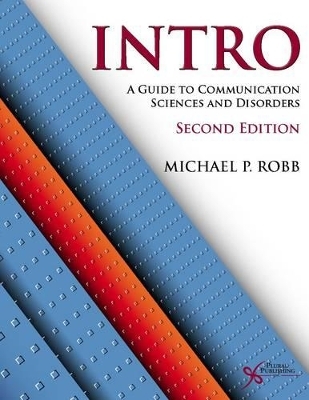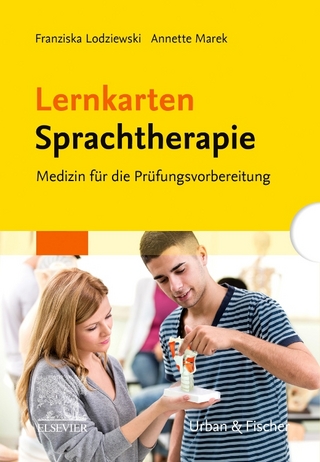
INTRO
Plural Publishing Inc
978-1-59756-542-4 (ISBN)
- Titel ist leider vergriffen;
keine Neuauflage - Artikel merken
Designed for undergraduate-level students, INTRO delivers fundamental information about various communication disorders. This second edition is beautifully illustrated and written in an engaging, yet straightforward approach - with an overview of the formative history, as well as current theories and research provided for each disorder. This edition maintains the strong international focus of the previous edition, with coverage of country-specific incidence and prevalence of various communication disorders in each chapter. Each chapter has also been updated to include highlights of current technological and research advances taking place in various areas of communication sciences and disorders. The text includes real-life examples in the form of video links in each chapter to help reinforce the information in the text. An Instructor's CD contains PowerPoint slides and test questions for use in the classroom.
Michael P. Robb has worked as a speech-language pathologist at the Meyer Children's Rehabilitation Institute in Omaha, Nebraska (now known as the Munroe-Meyer Institute for Genetics and Rehabilitation). Since obtaining his PhD, he has held faculty posts at the University of Hawaii, the University of Connecticut, and most recently at the University of Canterbury in Christchurch, New Zealand.
Foreword by John H. Saxman, PhD Preface SECTION 1. BACKGROUND TO COMMUNICATION DISORDERS 1. Communication Science Objectives Introduction Terminology and Definitions Animal Communication History of Human Communication Models of Communication Forms of Communication Levels of Communication Current Research in Communication Science Study Questions References 2. Communication Disorders and the Professions Objectives Introduction Terminology and Definitions The Professions History of the Professions Educational Preparation Professional Work Settings Professional Code of Ethics Cultural Considerations and Communication Disorders Current Issues in the Professions The Professions of Audiology and Speech-Language Pathology on the World Wide Web Study Questions References Appendix 2-A 3. Anatomical Processes of Speech and Hearing Objectives Introduction Speech Anatomy The Process of Speech Production Hearing Anatomy The Process of Hearing Historic Aspects of Anatomy and Physiology Cultural Considerations and Anatomy and Physiology Current Research in Speech and Hearing Anatomy and Physiology Anatomy and Physiology on the World Wide Web Study Questions References SECTION 2. DEVELOPMENTAL COMMUNICATION DISORDERS 4. Child Language Disorders Objectives Introduction Terminology and Definitions Language Development Historic Aspects of Child Language Disorders Types of Child Language Disorders Current Theories Regarding Child Language Developmental and Disorders Assessment of Child Language Disorders Treatment of Child Language Disorders Cultural Considerations and Child Language Disorders Current Research in Child Language Disorders Child Language Disorders and the World Wide Web Study Questions References 5. Child Phonological Disorders Objectives Introduction Terminology and Definitions Historic Aspects of Child Phonological Disorders Types of Phonological Disorders Current Theories Regarding Child Phonological Disorders Assessment of Child Phonological Disorders Treatment of Child Phonological Disorders Cultural Considerations and Child Phonological Disorders Current Research in Child Phonological Disorders Child Phonological Disorders on the World Wide Web Study Questions References 6. Fluency Disorders Objectives Introduction Terminology and Definitions Historic Aspects of Fluency Disorders Types of Fluency Disorders Current Theories Regarding Fluency Disorders Cultural Considerations and Fluency Disorders Current Research in Fluency Disorders Fluency Disorders on the World Wide Web Study Questions References 7. Cleft Lip and Palate Objectives Introduction Terminology and Definitions Historic Aspects of Cleft Lip and Palate Disorders of Cleft Lip and Palate Assessment of Cleft Lip and Palate Treatment of Cleft Lip and Palate Cultural Considerations and Cleft Lip and Palate Current Research in Cleft Lip and Palate Cleft Lip and Palate on the World Wide Web Study Questions References SECTION 3: ACQUIRED AND GENETIC COMMUNICATION DISORDERS 8. Voice Disorders Objectives Introduction Terminology and Definitions Historic Aspects of Voice Disorders Types of Voice Disorders Current Theories of Voice Disorders Assessment of Voice Disorders Treatment of Voice Disorders Cultural Consideration and Voice Disorders Current Research in Voice Disorders Voice Disorders on the World Wide Web Study Questions References 9. Neurogenic Communication Disorders Objectives Introduction Terminology and Definitions Historic Aspects of Neurogenic Communication Disorders Types of Neurogenic Communication Disorders Current Theories Regarding Neurogenic Communication Disorders Assessment of Neurogenic Communication Disorders Treatment of Neurogenic Communication Disorders Cultural Considerations and Neurogenic Communication Disorders Current Research in Neurogenic Communication Disorders Neurogenic Communication Disorders on the World Wide Web Study Questions References 10. Dysphagia Objectives Introduction Terminology and Definitions Historic Aspects of Dysphagia Types of Dysphagia Causes of Dysphagia Assessment of Dysphagia Treatment of Dysphagia Cultural Considerations and Dysphagia Current Research in Dysphagia Dysphagia on the World Wide Web Study Questions References 11. Genetics and Syndromes Objectives Introduction Terminology and Definitions Historic Aspects of Genetics Types of Syndromes Assessment of Genetics and Syndromes Treatment of Genetic Conditions Cultural Considerations Regarding Genetics Current Research in Genetics Genetics and Syndromes on the World Wide Web Study Questions References SECTION 4: AUDITION 12. Hearing Disorders Objectives Introduction Terminology and Definitions Historic Aspects of Hearing Disorders Types of Hearing Disorders Assessment of Hearing Disorders Cultural Considerations and Hearing Disorders Current Research in Hearing Disorders Hearing Disorders on the World Wide Web Study Questions References 13. Auditory Rehabilitation Objectives Introduction Terminology and Definitions Historic Aspects of Aural Rehabilitation Treatment Approaches: Hearing Rehabilitation Treatment Approaches: Speech and Language Rehabilitation Cultural Considerations and Aural Rehabilitation Current Research in Aural Rehabilitation Study Questions References Glossary Index
| Zusatzinfo | 4 colour illustrations |
|---|---|
| Verlagsort | San Diego |
| Sprache | englisch |
| Maße | 178 x 254 mm |
| Gewicht | 1315 g |
| Themenwelt | Medizin / Pharmazie ► Gesundheitsfachberufe ► Logopädie |
| ISBN-10 | 1-59756-542-3 / 1597565423 |
| ISBN-13 | 978-1-59756-542-4 / 9781597565424 |
| Zustand | Neuware |
| Haben Sie eine Frage zum Produkt? |
aus dem Bereich


